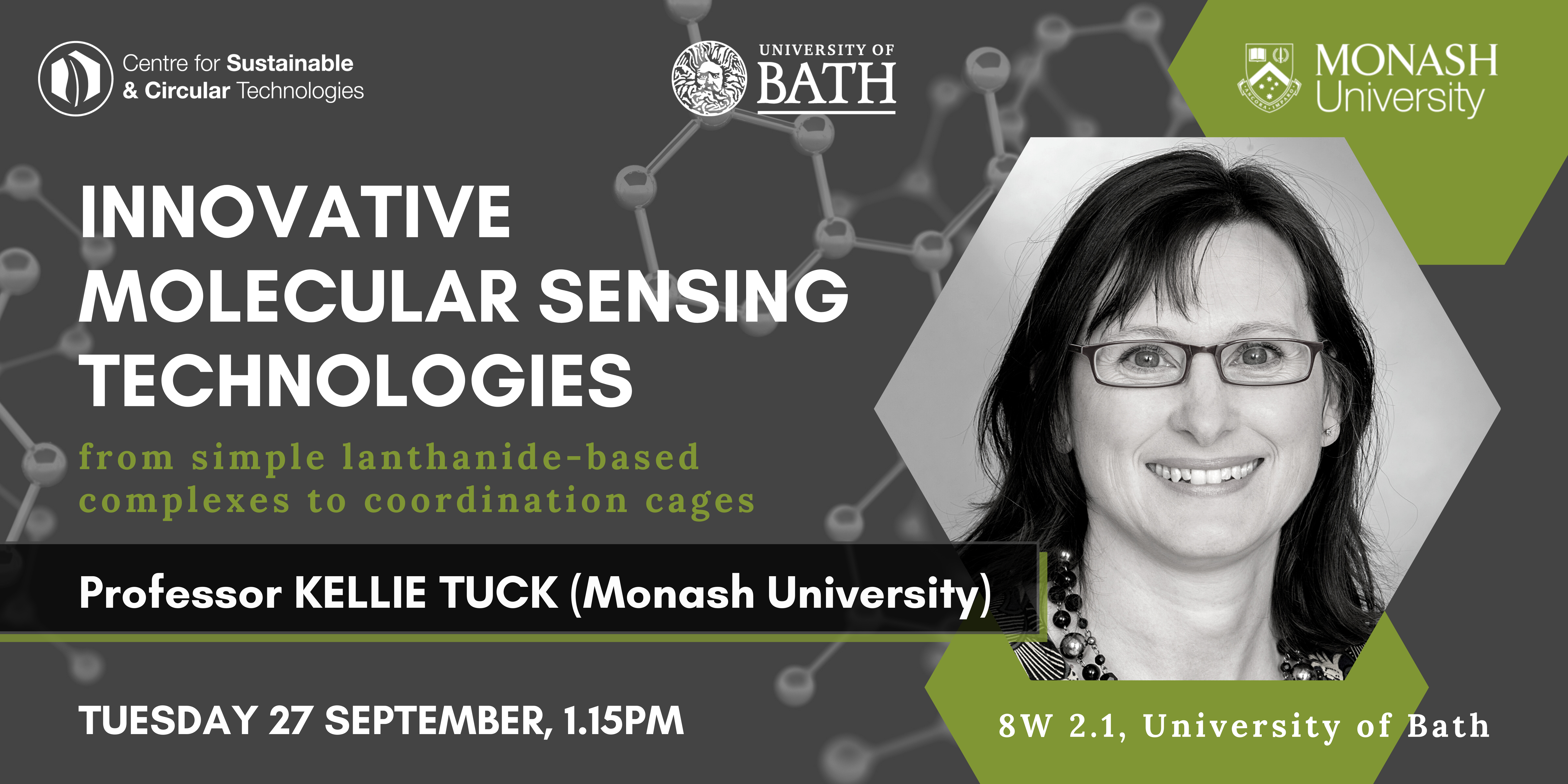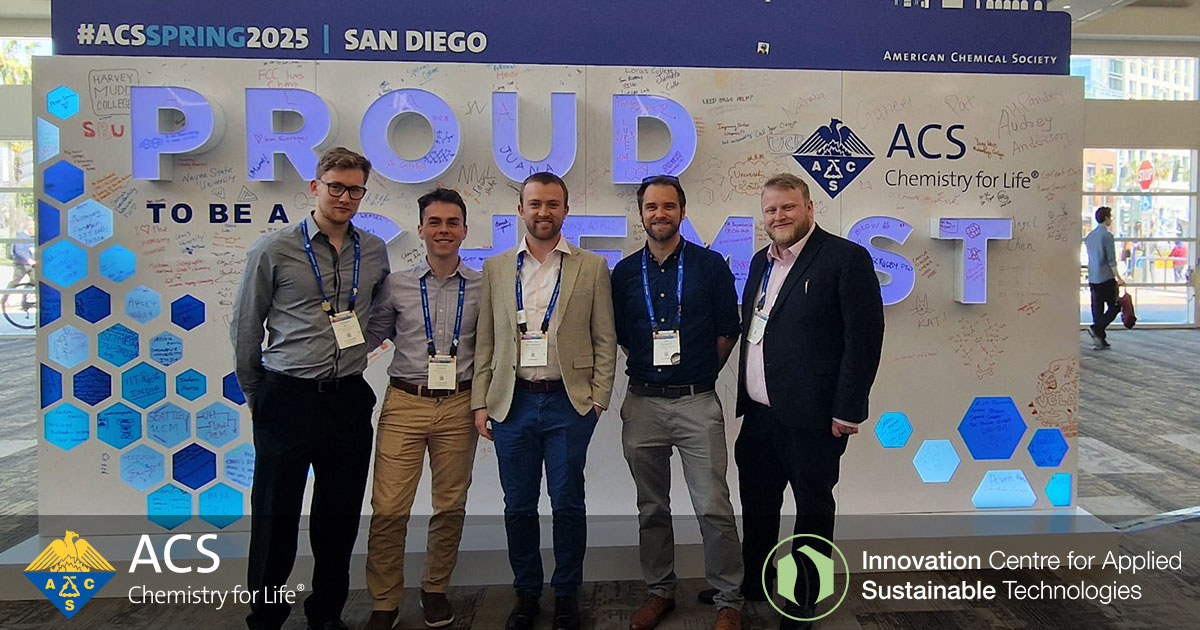
Innovative molecular sensing technologies
You are warmly invited to a seminar on Innovative molecular sensing technologies – from simple lanthanide-based complexes to coordination cages sponsored by the Centre for Sustainable & Circular Technologies. We are delighted to host a talk from Professor Kellie Tuck at Monash University. The seminar will take place on Tuesday 27th September, from 1:15pm, in 8 West 2.1.
The confirmed speakers are:
- Matthew Oshinowo, CSCT PhD researcher: Bio-Derived Polymer Electrolytes for Safer, Cheaper & More Sustainable Lithium-Ion Batteries
- Professor Kellie Tuck, Associate Head of Education, School of Chemistry, Monash University: Innovative molecular sensing technologies – from simple lanthanide-based complexes to coordination cages
DATE AND TIME
27 Sep 2022, 1.15pm
LOCATION
8 West 2.1, University of Bath
PLEASE NOTE
This is an in-person event.
Abstract
The unique and fascinating optical properties of lanthanide ions have intrigued scientists for decades; and their potential for optical sensing applications is starting to be realised.1 Lanthanides themselves are weakly luminescent, however when paired with an appropriate sensitiser, energy transfer from an energy-harvesting moiety to the lanthanide occurs. This resulting long-lived luminescence allows for time-gated signal detection thus eliminating interference from the short-lived fluorescence, a very useful endeavour when sensing analytes in biological or environmental solutions. We have, over a number of years, developed luminescent lanthanide-based complexes for detection of metal ions,2 nucleotides, as well as hydrogen sulfide in aqueous solutions (Fig. 1 a and b) and gaseous hydrogen sulfide.3 More recently we have been investigating highly charged coordination cages (Fig. 1 c and d) for their potential to detect and detoxify organophosphorus nerve agents and pesticides.4 These cages have been shown to catalyse hydrolysis reactions in aqueous solutions due to presence of hydroxide anions accumulated at the exterior surface of the cage.4 Lanthanide-based cages can allow for detection of toxic organophosphorous compounds via modulation of the luminescence.
This presentation will describe our recent findings in these areas, with an emphasis on the supramolecular chemistry as well as a discussion on how these research findings contribute to the sustainable development goals.
Fig. 1: (a) the HS– sensing principle of a lanthanide-based sensor;3 (b) paper discs illuminated with a UV lamp showing the turn-off and turn-on in the presence of Cu2+ ions and HS–; (c) a schematic of the cage;4 (d) space filling diagram showing the hollow cavity of the cage.
References
- M. L. Aulsebrook, M. R. Grace, B. Graham and K. L. Tuck, “Lanthanide complexes for luminescence-based sensing of low molecular weight analytes” Coord. Chem. Rev., 375, 191, (2018).
- M. R. Winnett, P. Mini, M. R. Grace and K. L. Tuck, “Time-resolved terbium-based probe for the detection of zinc(II) Ions: investigation of the formation of a luminescent ternary complex”Inorg. Chem., 59, 1, 118, (2020).
- P. Mini, M. A. Springer, M. R. Grace, G. H. Dennison, K. L. Tuck, “A highly efficient red-emitting luminescent paper-based chemosensor for hydrogen sulfide” Chem. Commun., 56, 5605, (2020).
- M. D. Ludden, C. G. Taylor, M. B. Tipping, J. S. Train, N. H. Williams, J. C. Dorrat, K. L. Tuck, and M. D. Ward, “Interaction of anions with the surface of a coordination cage in aqueous solution probed by their effect on a cage-catalysed Kemp elimination” Chem. Sci.,12, 14781, (2021) and unpublished work.
Biography
Kellie Tuck received her PhD from the University of Adelaide and, after holding postdoctoral positions at the University of South Australia and the University of Cambridge, commenced her independent career within Monash University’s School of Chemistry in 2004. She was promoted to A/Professor in 2018. She is currently Head of Teaching in the School of Chemistry and her research spans the areas of medicinal and supramolecular chemistry. Her projects involve extensive collaborative interaction with Australian and overseas academics, as well as several industry partners and government organisations. Over the past decade, her group has made significant contributions to the development of small molecules for treating neuropathic pain. More recently, it has become increasingly recognised for its innovative work on the host-guest chemistry of small molecule complexes and coordination cages for the rapid and sensitive detection of environmentally and biologically relevant species.







